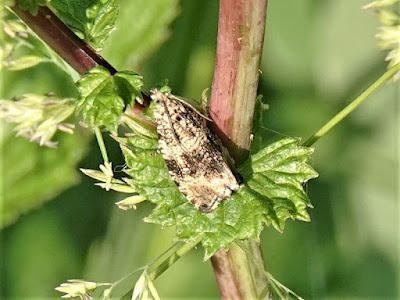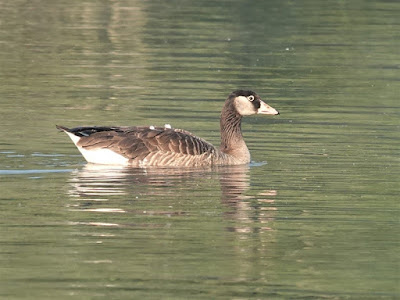12.0°C > 20.0°C: Almost cloudless. Light, mainly easterly breezes. Very good visibility. Much fresher.
Sunrise: 04:46 BST still
* = a photo of this species today
Priorslee Balancing Lake: 05:00 – 06:10 // 07:10 – 09:45
(127th visit of the year)
Bird notes:
- Hardly back to 'normal' though the adult and two cygnet Mute Swans emerged from cover at least twice. The cob took time out to drive the Mallard off the water on to the dam.
- No Sedge Warbler noted.
Birds noted flying over here:
- 1 Stock Dove
- 11 Wood Pigeons
- 1 Collared Dove
- 1 Lesser Black-backed Gull
- 2 Jackdaws
- 2 Rooks
Warblers noted (the number singing in brackets):
- 1 (1) Cetti's Warbler
- 1 (1) Willow Warbler
- 13 (12) Chiffchaffs
- no Sedge Warbler
- 11 (9) Reed Warblers
- 15 (14) Blackcaps
- 1 (1) Garden Warbler
- 1 (1) Common Whitethroat
Hirundines etc., noted:
- 2 Swift
- 3 Barn Swallow
- House Martins heard only
Counts from the lake area: it remains very quiet
- 2 + 2 Mute Swans
- 3 (1♂) Mallard
- 3 Moorhens
- 33 + 35 (12 broods) Coots
- 11 + 4 (1 brood) Great Crested Grebes
- 1 Lesser Black-backed Gull
+ = my first sighting of this species here this year.
++ = new species for me at this site.
Noted on and around the street lamp poles around dawn:
- 1 as yet unidentified spider
Noted later:
This a provisional list: I have not yet had time to examine all my photos.
Butterflies:
- Large Skipper (Ochlodes sylvanus)
- Meadow Brown (Maniola jurtina)
- Large Skipper (Ochlodes sylvanus)
- Meadow Brown (Maniola jurtina)
Moths:
- Timothy Tortrix (Zelotherses paleana)
- Common Marble (Celypha lacunana)
- Blood-vein (Timandra comae)
- Silver-ground Carpet (Xanthorhoe montanata)
- Burnet Companion (Euclidia glyphica)
- Straw Dot (Rivula sericealis)
- Timothy Tortrix (Zelotherses paleana)
- Common Marble (Celypha lacunana)
- Blood-vein (Timandra comae)
- Silver-ground Carpet (Xanthorhoe montanata)
- Burnet Companion (Euclidia glyphica)
- Straw Dot (Rivula sericealis)
Bees / wasps etc.:
- Honey Bee (Apis mellifera)
- Garden Bumblebee (Bombus hortorum)
-. Tree Bumblebee (Bombus hypnorum)
- Red-tailed Bumblebee (Bombus lapidarius)
- Early Bumblebee (Bombus pratorum)
- Buff-tailed Bumblebee (Bombus terrestris)
Tenthredo sp. sawfly
- Honey Bee (Apis mellifera)
- Garden Bumblebee (Bombus hortorum)
-. Tree Bumblebee (Bombus hypnorum)
- Red-tailed Bumblebee (Bombus lapidarius)
- Early Bumblebee (Bombus pratorum)
- Buff-tailed Bumblebee (Bombus terrestris)
Tenthredo sp. sawfly
Dragon-/damsel-flies:
- Azure Damselfly (Coenagrion puella)
- Common Blue Damselfly (Enallagma cyathigerum)
- Red-eyed Damselfly (Erythromma najas)
- Blue-tailed Damselfly (Ischnura elegans)
- Black-tailed Skimmer (Orthetrum cancellatum)
- Azure Damselfly (Coenagrion puella)
- Common Blue Damselfly (Enallagma cyathigerum)
- Red-eyed Damselfly (Erythromma najas)
- Blue-tailed Damselfly (Ischnura elegans)
- Black-tailed Skimmer (Orthetrum cancellatum)
Hoverflies:
- Marmalade Hoverfly (Episyrphus balteatus)
- Tapered Dronefly (Eristalis pertinax)
- Common Dronefly (Eristalis tenax)
- Migrant Field Syrph or Migrant Hoverfly (Eupeodes corollae)
- Common Spotted Field Syrph (Eupeodes luniger)
- Common Twist-tail (Sphaerophoria scripta) [was Long Hoverfly]
- Bumblebee Plume-horned Hoverfly (Volucella bombylans)
- Marmalade Hoverfly (Episyrphus balteatus)
- Tapered Dronefly (Eristalis pertinax)
- Common Dronefly (Eristalis tenax)
- Migrant Field Syrph or Migrant Hoverfly (Eupeodes corollae)
- Common Spotted Field Syrph (Eupeodes luniger)
- Common Twist-tail (Sphaerophoria scripta) [was Long Hoverfly]
- Bumblebee Plume-horned Hoverfly (Volucella bombylans)
Other flies:
- Black Snipefly (Chrysopilus cristatus)
- Scorpion Fly Panorpa sp.
- midge with patterned wings
- Black Snipefly (Chrysopilus cristatus)
- Scorpion Fly Panorpa sp.
- midge with patterned wings
Beetles:
- Lesser Thick-legged Flower Beetle (Ischnomera cyanea)
- Swollen-thighed Beetle (Oedemera nobilis)
- Lesser Thick-legged Flower Beetle (Ischnomera cyanea)
- Swollen-thighed Beetle (Oedemera nobilis)
Bugs:
- 7 Spot Ladybird (Coccinella 7-punctata)
- Dock Bug (Coreus marginatus)
- +Hairy Shieldbug [aka Sloe Bug] (Dolycoris baccarum)
- Mirid bug, perhaps Oncotylus viridiflavus
- 7 Spot Ladybird (Coccinella 7-punctata)
- Dock Bug (Coreus marginatus)
- +Hairy Shieldbug [aka Sloe Bug] (Dolycoris baccarum)
- Mirid bug, perhaps Oncotylus viridiflavus
Also
- White-lipped Snail (Cepaea hortensis)
- small money spider sp.
- White-lipped Snail (Cepaea hortensis)
- small money spider sp.
Early colour.
Faded by the time I scampered(?) to the lake side.
The quartet of Great Crested Grebe juveniles seems to be: one with one parent...
...and three with the other parent. I have wondered whether the sex of the juveniles and adults plays any part in this, if indeed it is always the same juveniles with the same parent. I can find nothing in the literature.
My friendly Reed Warbler still preferring to hide away.
A better photo of a Large Skipper butterfly (Ochlodes sylvanus). The diagonal mark in the forewing is the scent gland, indicating this is a male.
Same moth: another perspective.
A Common Marble moth (Celypha lacunana).
There were many bees feeding on the bramble flowers. Here is a Honey Bee (Apis mellifera).
Joining in was this Buff-tailed Bumblebee (Bombus terrestris) sporting a heavy load of pollen.
As here also.
It can still fly with its load.
This is an Azure Damselfly (Coenagrion puella). I am sure they are present every day but it is too tedious to check all the many hundred 'blues'. It was by chance I photographed this one. Identify by the wide blue (ante-humeral)stripe on the thorax and the 'U'-shaped black mark on the top visible body segment.
My and my shadow. A Blue-tailed Damselfly (Ischnura elegans) caught in flight.
I found this Black-tailed Skimmer dragonfly (Orthetrum cancellatum) resting in vegetation and not, as yesterday, on an open pathway.
A somewhat unusual Marmalade Hoverfly (Episyrphus balteatus) in that the narrower bands are not slightly orange-toned, as one might expect from its name.
With the lower two yellow bands not divided this has to be a Migrant Field Syrph or Migrant Hoverfly (Eupeodes corollae).
I now understand why Steven Falk changed the vernacular name of this hoverfly from Long Hoverfly to Common Twist-tail (Sphaerophoria scripta). All the hoverflies in this genus tend to twist their tails.
I need to double-check this hoverfly. I think it is a Bumblebee Plume-horned Hoverfly (Volucella bombylans)
An unusually marked midge I found on a wall of the sailing club HQ.
I think these must be two Lesser Thick-legged Flower Beetles (Ischnomera cyanea).
I assume the male is on the top – as is usual in insects. If so he seems significantly smaller than the female.
A Hairy Shieldbug [aka Sloe Bug] (Dolycoris baccarum).
I am sure this is a Mirid Bug. The closest match I can find is Oncotylus viridiflavus. I know a man...
I think this qualifies as a money spider. Here between two of my fingers.
Plane of the day: it is a Diamond Aircraft DA 42 Twin Star owned by Aeros Leasing of Coventry. This Austrian designed and built light aircraft is used by many commercial flying schools to give trainees experience with, a qualification on, twin-engined aircraft with and a retractable undercarriage.
(Ed Wilson)
------------------------------------------------------------------------------------------------------
The Flash: 06:15 – 07:05
(117th visit of the year)
Bird notes:
- Four Great Crested Grebes were present. One was seen to splash-down but may have been repositioning from elsewhere around the water. None was sitting on a nest and there was no indication that there were any juveniles around.
Birds noted flying over here:
- 1 Lesser Black-backed Gull
- 5 Jackdaws: together
Warblers noted (the number singing in brackets):
- 5 (5) Chiffchaffs
- 5 (5) Blackcaps
Hirundines etc., noted:
None
Noted on / around the water
- 152 Canada Geese
- 1 Greylag x Canada Goose
- 28 Greylag Geese
- 2 + 4 Mute Swans
- 25 (20♂) Mallard
- 1 (1♂) all-white duck (Peking(?) Duck)
- 10 (6♂) Tufted Duck
- 4 + 1 (1 brood) Moorhens
- 23+ 9 (5 broods) Coots: one very new brood of just two
- 4 Great Crested Grebes
- 1 Grey Heron
On / around the street lamp poles around the water:
Nothing noted
- 152 Canada Geese
- 1 Greylag x Canada Goose
- 28 Greylag Geese
- 2 + 4 Mute Swans
- 25 (20♂) Mallard
- 1 (1♂) all-white duck (Peking(?) Duck)
- 10 (6♂) Tufted Duck
- 4 + 1 (1 brood) Moorhens
- 23+ 9 (5 broods) Coots: one very new brood of just two
- 4 Great Crested Grebes
- 1 Grey Heron
On / around the street lamp poles around the water:
Nothing noted
** three moths on three different poles yesterday: zilch today.
Noted elsewhere:
- Alder Leaf Beetle (Agelastica alni)
Noted elsewhere:
- Alder Leaf Beetle (Agelastica alni)
The goose that is unsure whether it is a Canada Goose or a Greylag Goose.
Not quite-enough light to freeze he action as a drake Tufted Duck noisily pursues a duck.
(Ed Wilson)
------------------------------------------------------------------------------------------------------
On this day can be found via the yearly links in the right-hand column.
Sightings from previous years without links are below
2010
Priorslee Lake
5+ Willow Tits in the trees alongside the M54 slip-road
(J W Reeves)
2006
Priorslee Lake
Just 2 Mute Swan cygnets remaining, possible Mink in the area
(Martin Adlam)



























